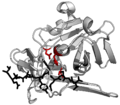Protease facts for kids
A protease is a special kind of enzyme that helps break things down. Think of it like a tiny pair of scissors inside your body and in other living things! Its main job is to cut long chains of proteins into smaller pieces called amino acids. These smaller pieces are easier for living things to use.
Proteases are super important for many life processes. For example, they help us digest food, make our blood clot when we get a cut, and even help our immune system fight off germs.
Contents
What Proteases Do
Proteases are like recycling experts for proteins. Proteins are big, complex molecules that do many jobs in our bodies, like building muscles or sending signals. When a protein is no longer needed, or if it needs to be changed, a protease steps in. It cuts the protein at specific spots, breaking it down into its basic building blocks, the amino acids. These amino acids can then be reused to make new proteins.
Where Proteases Are Found
You can find proteases almost everywhere there's life! They are in:
- Animals: Like in your stomach, helping you digest food.
- Plants: Helping them grow and process nutrients.
- Bacteria and Archaea: Tiny living things that use proteases for their own life processes.
- Viruses: Some viruses even use proteases to help them spread and make copies of themselves.
Different Kinds of Proteases
Scientists have discovered more than 50 different kinds of proteases. Even though they all do the same basic job – breaking down proteins – they can do it in very different ways. This is a bit like how many different tools can cut something, but each tool works a little differently. This shows that proteases have evolved many times over history.
Some of the main types of proteases are:
- Serine proteases
- Threonine proteases
- Cysteine proteases
- Aspartate proteases
- Metallo proteases
- Glutamic acid proteases
Each type is named based on a specific amino acid or metal that helps it do its cutting job.
Images for kids
-
The structure of a protease (TEV protease) complexed with its peptide substrate in black with catalytic residues in red.(PDB 1LVB)
See also
 In Spanish: Peptidasa para niños
In Spanish: Peptidasa para niños


